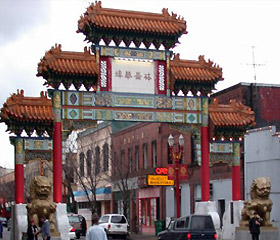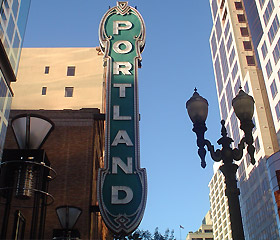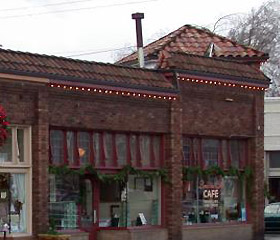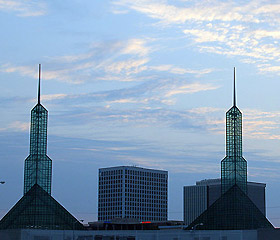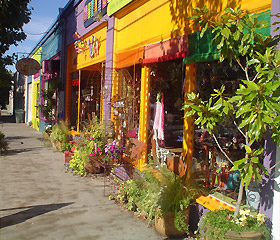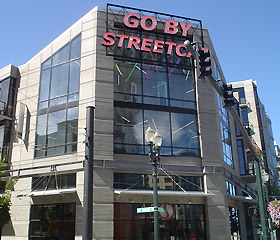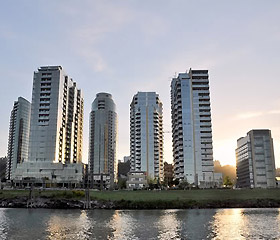Portland, Oregon’s largest city, is currently experiencing rapid growth but has so far avoided many of the problems, such as urban sprawl, that are usually associated with expansion. The city’s urban growth boundary has kept the metropolitan area compact and has become a model for other cities in the United States.
Generally speaking, Portland is divided roughly on a grid with two main dividing lines – Burnside St. divides North and South, and the Willamette River divides East and West. The East side of the river retains the grid system for quite a distance from the river, making street addresses really easy to find. For instance – trying to figure out where 1629 SE Hawthorne is. That’s easy – it’s near the corner of 16th and SE Hawthorne. (This trick gets harder to use when you’re trying to figure out where someplace like 5320 NE 33rd is – unless you happen to know which street is 53 away from Burnside.) The West side of the river is less attached to the grid system once you get out of the downtown area and NW Portland, but anywhere with a grid, it’s easy to find your way around – once you understand the system.
In addition to the major neighborhoods in Portland, there are sub-neighborhoods that are also commonly known around town. Some of them are listed here, too.
Portland is a city of neighborhoods, each with its own distinct personality. But taken together, they make up the quirky charm that is Portland.
Downtown
Portland’s downtown area, on the West side of the Willamette River, is compact and easily walkable (especially the main shopping and dining areas). You may notice that the city blocks seem smaller than average city blocks, and you’d be right. More corners meant more expensive corner office real estate! There are lots of one-way streets in downtown Portland, which can make it a challenge to navigate if you’re driving and aren’t sure where you’re going. When walking, however, they’re not a problem at all. SW Portland, of which downtown is a major part, stretches up into the West Hills (full of mansions and windy roads).
NW Portland
Part of NW Portland often gets lumped in with downtown because of proximity, but because it lies on the other side of Burnside it’s technically in NW and not SW Portland. The areas which are easily accessible from downtown are Chinatown, Old Town and The Pearl District, each with its own character. Going further northwest of downtown puts you in the neighborhood locals traditionally are referring to when they say “NW Portland” – the area around NW 23rd and 21st Avenues. While the Pearl is a newer upscale development, NW 23rd and 21st are old upscale. That small area is known primarily for its fun and often funky (though still usually high-end) assortment of shops, restaurants and bars – as well as a distinct lack of parking. It’s well worth a visit, just be sure to ditch the car downtown and take the tram.
NE Portland
NE Portland has been working its way from being partly sketchy to mostly fantastic over the last several years. Whereas some parts of NE Portland used to be places where locals (at least those who didn’t live in the area) didn’t want to go, most of NE Portland has become a desirable place to live. The Laurelhurst area has long been full of old money and old mansions. More and more restaurants and businesses moving into NE Portland are continuing the upward trend, and the area is also home to many Portland artists.
SE Portland
SE Portland has long been the most hippie-centric neighborhood of what is a left-leaning city – there’s an area in SE that’s affectionately known as the “People’s Republic” – although prices have risen enough in recent years to drive many long-time residents into NE. SE Portland includes Mt. Tabor Park, the park on the city’s own little distinct volcano. Hawthorne Blvd. is the traditional center of the area’s bohemian culture. The area known as Ladd’s Addition doesn’t follow the grid system of the rest of the East side, so it’s easy to get turned around in there. If you get out as far as SE 82nd., you’re likely to find lots of used car lots and Asian markets.
North Portland
North Portland refers to the area that the Willamette River would run through if it didn’t take a left turn after leaving downtown. It’s becoming more developed as people leave NE Portland (as the prices go up) and settle in North Portland to fix up the lovely old homes and beautify the neighborhoods. Some notable sub-neighborhoods are just streets along which there is a heavy concentration of shops or restaurants – like Albina or Mississippi.
Most popular neighborhoods in Portland
Below are a few of the most popular neighborhoods in Portland:
Chinatown
South of the Broadway Bridge and behind an ornate red gate guarded by a pair of golden lions, is Portland’s Old Town Chinatown, a neighborhood rich in the history of the early days of Portland. One of the more interesting facts lies under Portland…
Downtown Portland
Downtown Portland centers around Pioneer Courthouse Square, a lively central public meeting place. The Square is the most visited site in Portland and hosts more than 300 events a year such as political rallies, festivals, and concerts. Pioneer…
Hawthorne District
The Hawthorne District is a popular avant-garde neighborhood just across the Willamette River from Downtown that runs along Hawthorne Boulevard between 17th and 43rd Avenues. The Boulevard is lined with locally-owned coffee shops, antique stores,…
Lloyd District
The Lloyd District lies across the Willamette River from downtown Portland and is easily accessible by the MAX light rail, the Vintage Trolley, and several Tri-Met bus routes. Car-less workers who commute to the Lloyd District are eligible to join…
Nob Hill
Nob Hill is a sophisticated, yet trendy, neighborhood surrounding the very popular NW 21st and Northwest 23rd Streets. Locally, the area is also often called Northwest or “Trendy-first and Trendy-third”. Similar to its sister neighborhood, the…
Pearl District
What was once a decaying industrial warehouse area in downtown Portland, the Pearl District has undergone significant renovation and is now Portland’s premier urban-chic neighborhood. Many of the aging warehouses have been turned into luxurious…
South Waterfront
The River Blocks at South Waterfront is Portland’s newest urban renewal project along the Willamette River in Downtown Portland. Baby boomers and urban professionals seeking urban housing have fueled a great demand for more condos in Portland…
Other Metropolitan-Area Neighborhoods
Portland’s metropolitan area includes the cities of Beaverton, Fairview, Gresham, Hillsboro, Lake Oswego, Milwaukie, Oregon City, Tigard, Troutdale, Tualatin, and Vancouver, Washington.
Alberta
The Alberta Arts District is a thriving arts community and is one of Portland’s most unique multicultural neighborhoods. Currently, in the midst of revitalization, it is also one of Portland’s oldest neighborhoods. Once a month, the Arts District is host to the Last Thursday Art Walk. On this festive evening, local, regional, and national artists show their works at the many galleries, studios, and cafes that line Northeast Alberta Street between Martin Luther King Jr. Boulevard and 33rd Avenue. Popular restaurants in this neighborhood are Taqueria La Serenita and Vita Café.
West Hills
What is locally called the West Hills is actually a collection of smaller neighborhoods. They are Arlington Heights, Council Crest, Forest Heights, Hillside, Forest Park, Northwest Heights, and Portland Heights. The West Hills overlooks the city of Portland from a ridge that extends from the northwest to the southwest. Many people desire to live in this community because of the short commute into the city and the beautiful views that many of the homes offer. They also love the narrow, winding streets and beautiful, older homes with classical architectural style. Some of the newer, more contemporary-style homes and condos that have been built in recent years hug the steeper terrain of the hills but offer their occupants stunning views of the city and Mount Hood to the east. Also located in the West Hills, is Forest Park, which at 5,127 acres, is the largest forested city park in the United States.
Beaverton
Beaverton is one of the fastest-growing cities in Oregon. Its controversial annexation plan could, in ten years’ time, make Beaverton the second largest city in Oregon. Located just outside the city limits is the 750 acre Nike campus and also Tektronix, one of Oregon’s largest employers. The Westside MAX light rail recently expanded into Beaverton and its western neighbor, Hillsboro.
Lake Owsego
The upscale city of Lake Oswego centers around a private, city-owned lake of the same name. The meandering, narrow streets and picturesque views of the lake and the Willamette River make Lake Oswego a desirable place to live. Downtown Lake Oswego is comprised of a mix of restaurants, charming shops, and offices. The arts are very important to the citizens of Lake Oswego as shown to their dedication to establishing and supporting the Lakewood Center for the Arts, a non-profit community cultural center that sponsors visual arts, theatre, and community events.
Sherwood / Tualatin
Sherwood has had an explosion in population over the past fifteen years as the Portland metropolitan area continues to expand its urban growth boundaries. It is consistently one of the state’s fastest-growing cities. The town was originally called Smockville, named after the founder, J.C. Smock, but was changed to Sherwood in 1892. What was once a small town that based its economy on the local fruit and vegetable cannery is now a medium-sized city with its spotlight on family and community.
Gresham
Gresham is located on the northeastern boundary of the Portland metropolitan area on the Columbia River and is the gateway to the Columbia River Gorge. It is the fourth-largest city in Oregon. Gresham is host to one of the nation’s longest-running jazz festivals, Mt. Hood Jazz Festival. The city has some of the best views of Mt. Hood in the Portland metro area.
Mt Tabor
At the heart of the Mt. Tabor neighborhood is Mt. Tabor Park, located at SE 60th and Salmon in Southeast Portland. This is one of the city’s larger parks and features a 600-foot extinct volcano located in the northwest corner of the park. Miles of walking and bike trails wind through the tall firs to the top of the volcano. The park also has picnic tables an amphitheater, and an off-leash dog park. Several picturesque freshwater reservoirs hold much of Portland’s drinking water.
Rocky Butte
Rocky Butte is one of the many small volcanoes and cinder cones in the Boring Lava Field that was created before the ice age. It is located just south of the Portland International Airport and was once the site of the Hill Military Academy and also the Multnomah County Jail. From Joseph Wood Hill Park at the top of the butte, the 360-degree view is breathtaking. On a clear day, the Portland International Airport, the Columbia River, Mt. Hood, and Mt. St. Helens can be seen. At the base of the cliff is The Grotto, a 62-acre sanctuary owned by the Roman Catholic Church. Along with miles of contemplative trails, the Grotto features a large niche carved into the lava basalt cliff that contains Italian marble statuary.
